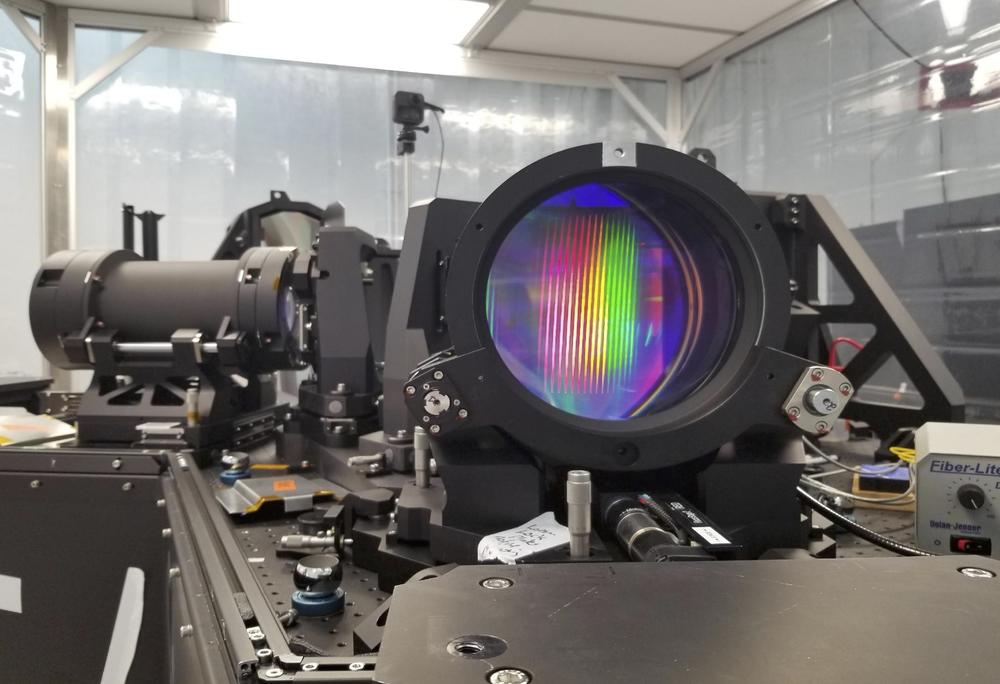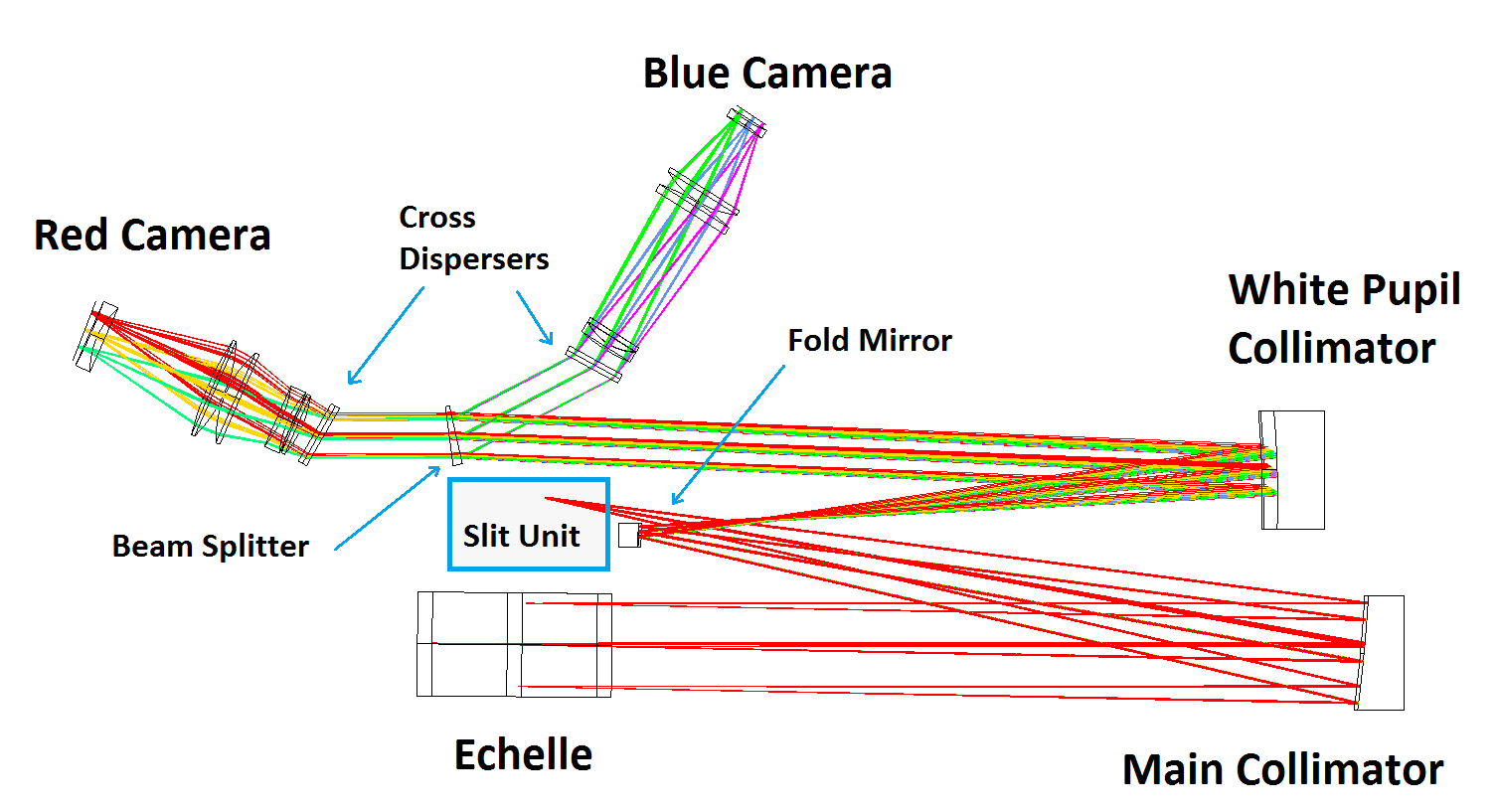
2025B Call for Proposals
- GHOST is offered in standard, and high-resolution mode, as well as for non-sidereal targets and faint targets requiring blind-offsets.
- The precision radial velocity mode (with simultaneous calibration lamp) is not offered.
Outline of Documentation
- Capabilities
- Components
- Proposal preparation
- Calibrations
- Exposure Time Estimation
- Obsevation preparation
- Data Reduction
- GHOST Community Webinars
- System Verification
- Documentation
Capability Summary
Spectroscopy
- Total wavelength range: 347-1060 nm. Usable wavelength range (383-1000nm)
- Spectral element resolution (R) of 56,000 in standard resolution (2 IFUs simultaneously).
- Spectral element resolution of 76,000 in high resolution mode (1 IFU).
- Simultaneous ThXe arc calibrations can be taken along with science (only in high resolution) in precision radial velocity mode. Not yet commissioned.
- Atmosphere dispersion correction (ADCs) are provided for each IFU independently.
Integral field units
- Integral Field Unit (IFU) aperture: 1.2 arcsecs, which are reformatted into the spectrograph at slit widths of around 0.4 arcsecs at standard resolution, and 0.24 arcsecs at high resolution.
- 2 IFUs available for science for standard resolution.
- Field of view: 7.34 arcmins for two IFU mode, where the closest separation of the two IFUs is 102 arcsec.
- Dedicated sky IFUs available at both resolutions for sky subtraction.
Guiding Options
- Guided using Periferal Wavefront Sensor 2 (PWFS2).
- Fine guiding provided by dedicated fibres surrounding the IFU.
GHOST, the Gemini High-resolution Optical SpecTrograph is the new Gemini facility instrument that provides high-resolution spectroscopic capabilities. It has a wide simultaneous wavelength coverage with high observational efficiency. It allows astronomers to investigate a broad range of science from the composition of the first stars to the characterization of exo-planetary systems. It consists of three primary components; a cassegrain unit mounted on the telescope, a spectrograph bench in a highly stable encloure at the pier lab, and a fiber cable connecting the two. The on-telescope cassegrain unit contains the positioning system for the object and sky fiber IFUs. Each object IFU is equipped with mini-ADCs.
The bench spectrograph is isolated in the telescope pier lab for image and wavelength stability. It is an echelle white-pupil design, having a blaze angle of 65°. After white-pupil collimation, the light is split at 530 nm into a blue and red arm, each provided with VPH gratings for cross dispersion. The spectra are recorded on a 4Kx4K detector for the blue spectra, and a 6Kx6K detector for the red spectra. A slit unit camera provides for object acquisition and active monitoring of the slit illumination. The bench uses active thermal stabilization to help provide the image and wavelength stability necessary for operation efficiency and radial velocity precision.
References
The current primary references to be cited by users of GHOST are:
1. Gemini High-resolution Optical SpecTrograph (GHOST) at Gemini-South: Instrument performance and integration, first science, and next steps , Kalari, V. M., Diaz, R. J., Robertson, G., McConnachie, A., Ireland, M. et al. 2024, AJ, 168, 208
2. The Science Performance of the Gemini High Resolution Optical Spectrograph, McConnachie, A., Hayes, C. R., Robertson, G., Pazder, J., Ireland, M. et al. 2024, PASP, 136
GHOST was built by a collaboration between Australian Astronomical Optics at Macquarie University, National Research Council Herzberg of Canada, and the Australian National University. The instrument scientist is Dr. Alan McConnachie at NRC, and also led by Dr. Gordon Robertson (at AAO), and Dr. Michael Ireland (at ANU). The Gemini integration and commissioning team included David Henderson, Venu Kalari, Chris Simpson, Manuel Gomez, Pablo Prado, Roque Ruiz, Ruben Diaz, Fredrik Rantakyro, Steve Margheim, and John Basset.
Announcements
Instrument Team
gs Instrument Scientist

gs Additional Support Staff
- Roque Ruiz
- Venu Kalari
- Emily Deibert
- Henrique Reggiani
- Cinthya Rodriquez
Email: ghost_science@noirlab.edu
